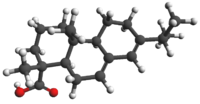Abietic acid (also known as abietinic acid or sylvic acid) is a mild organic acid found in coniferous trees.

| |

| |
| Names | |
|---|---|
| IUPAC name
Abieta-7,13-dien-18-oic acid
| |
| Systematic IUPAC name
(1R,4aR,4bR,10aR)-1,4a-Dimethyl-7-(propan-2-yl)-1,2,3,4,4a,4b,5,6,10,10a-decahydrophenanthrene-1-carboxylic acid | |
| Other names
Abietinic acid; Sylvic acid
| |
| Identifiers | |
3D model (JSmol)
|
|
| ChEBI | |
| ChEMBL | |
| ChemSpider | |
| ECHA InfoCard | 100.007.436 |
| EC Number |
|
| KEGG | |
PubChem CID
|
|
| RTECS number |
|
| UNII | |
CompTox Dashboard (EPA)
|
|
| |
| |
| Properties | |
| C20H30O2 | |
| Molar mass | 302.458 g·mol−1 |
| Appearance | Yellow resinous powder, crystals or chunks. Monoclinic plates (from EtOH/water). Colorless solid when pure. |
| Density | 1.06 g/mL |
| Melting point | 172–175 °C (342–347 °F; 445–448 K)[2] |
| Boiling point | 250 °C; 482 °F; 523 K |
| Insoluble[2] | |
| Solubility in other solvents | Very soluble in acetone, petroleum ether, Et2O, and ethanol |
| Hazards | |
| Occupational safety and health (OHS/OSH): | |
Main hazards
|
Irritant |
| GHS labelling: | |

| |
| Warning | |
| H317 | |
| P261, P272, P280, P302+P352, P321, P333+P313, P363, P501 | |
| NFPA 704 (fire diamond) | |
| Safety data sheet (SDS) | MSDS |
Except where otherwise noted, data are given for materials in their standard state (at 25 °C [77 °F], 100 kPa).
| |
It is a commercially important component of paints, soaps, foods, and soldering flux, and is the primary component of resin acid.
Characteristics
editAbietic acid is found in pine trees, including:
- Pinus insularis (Khasi Pine)
- Pinus kesiya Royle
- Pinus strobus (Eastern White Pine)
- Pinus sylvestris (Scots Pine).[3]
Pure abietic acid is a colorless solid, but commercial samples are usually a glassy or partly crystalline yellowish solid that melts at temperatures as low as 85 °C (185 °F).[4]
Abietic acid is soluble in alcohols, acetone, and ethers. Its ester or salt is called an abietate.[5]
Abietic acid belongs to the abietane diterpene group of organic compounds derived from four isoprene units.
Preparation
editAbietic acid is extracted from tree rosin[6] (via isomerization) and is the most abundant of several closely related organic acids that constitute most of rosin, the solid portion of the oleoresin of coniferous trees.
Resin acids are converted into ester gum by reaction with controlled amounts of glycerol or other polyhydric alcohols.
Uses
editAbietic acid has drying properties, and as ester gum is used in paints, varnishes, and lacquers.[4]
It is also used in soaps, for the analysis of resins, and the preparation of metal resinates.
As rosin
editRosin, of which abietic acid is the principal component:
- Has been used for centuries as a flux for soldering. (Abietic acid in the flux removes oxidation from the surfaces of metals, increasing their ability to bond with the liquified solder.)
- Is rubbed on the hair of a violin bow to increase friction.
- Has been used for centuries for caulking ships.[4]
- Is approved by the US FDA as a miscellaneous food additive.[7]
Safety
edit- As the chief component of rosin, abietic acid is approved by the US FDA as a miscellaneous food additive.[7]
- Abietic acid is considered a "nonhazardous natural substance" in tall oil ("liquid rosin").[5]
- In the U.S., abietic acid is listed in the inventory of the Toxic Substances Control Act.
- Abietic acid is the primary irritant in pine wood and resin. As a contact allergen[8] it is the cause of abietic acid dermatitis. (However, compounds resulting from its oxidation by air elicit stronger responses.) [9]
- 50% ethanol extracts from Resina pini of Pinus sp. (Pinaceae) showed inhibitory activity against testosterone 5α-reductase prepared from rat prostate. The fraction responsible for this activity was purified, and the active constituent was isolated and identified as abietic acid, which exhibited potent inhibitory activity against testosterone 5α-reductase in vitro.[10]
References
edit- ^ National Toxicology Program, Institute of Environmental Health Sciences, National Institutes of Health (NTP). 1992. National Toxicology Program Chemical Repository Database. Research Triangle Park, North Carolina
- ^ a b Merck Index, 12th Edition, 3. Abietic Acid
- ^ "Abietic Acid". Dr. Duke's Phytochemical and Ethnobotanical Databases. Archived from the original on 2015-09-23. Retrieved 13 January 2012.
- ^ a b c Hoiberg, Dale H., ed. (2010). "abietic acid". Encyclopædia Britannica. Vol. I: A-ak Bayes (15th ed.). Chicago, Illinois: Encyclopædia Britannica Inc. pp. 32. ISBN 978-1-59339-837-8.
- ^ a b Lars-Hugo Norlin "Tall Oil" in Ullmann's Encyclopedia of Industrial Chemistry 2002, Wiley-VCH, Weinheim.doi:10.1002/14356007.a26_057
- ^ G. C. Harris and T. F. Sanderson (1963). "Abietic Acid". Organic Syntheses. 32: 1; Collected Volumes, vol. 4, p. 1.
- ^ a b Nutrition, Center for Food Safety and Applied (2022-08-25). "Food Additive Status List". FDA.
- ^ El Sayed, F; Manzur, F; Bayle, P; Marguery, MS; Bazex, J (1995). "Contact urticaria from abietic acid". Contact Dermatitis. 32 (6): 361–2. doi:10.1111/j.1600-0536.1995.tb00628.x. PMID 7554886. S2CID 36139468.
- ^ Hausen, BM; Krohn, K; Budianto, E (1990). "Contact allergy due to colophony (VII). Sensitizing studies with oxidation products of abietic and related acids". Contact Dermatitis. 23 (5): 352–8. doi:10.1111/j.1600-0536.1990.tb05171.x. PMID 2096024. S2CID 34726630.
- ^ Seong-Soo Roh, Moon-Ki Park and Yong-ung Kim (2010). "Abietic Acid from Resina Pini of Pinus Species as a Testosterone 5α-Reductase Inhibitor". J. Health Sci. 56 (4): 451–455. doi:10.1248/jhs.56.451.
